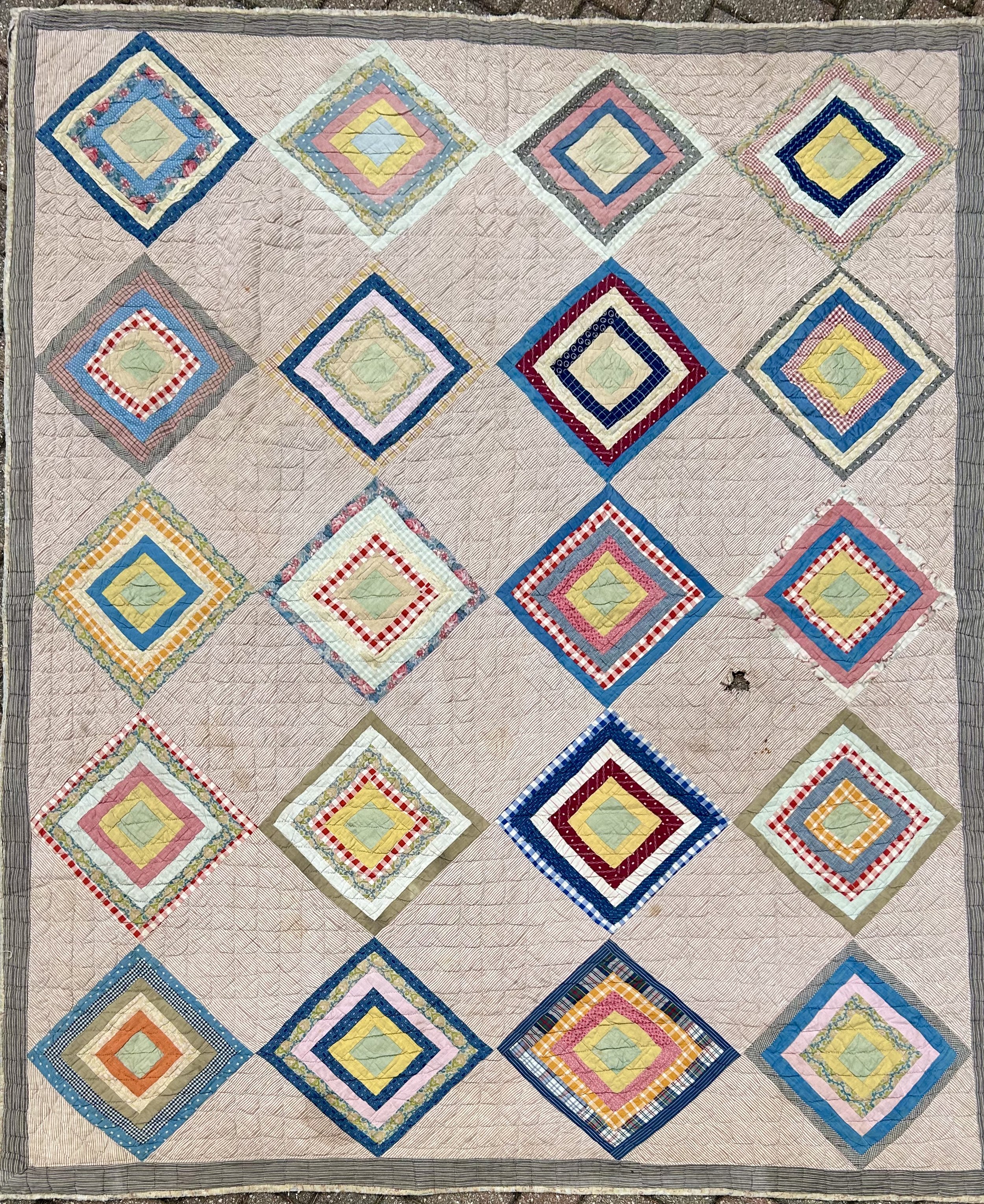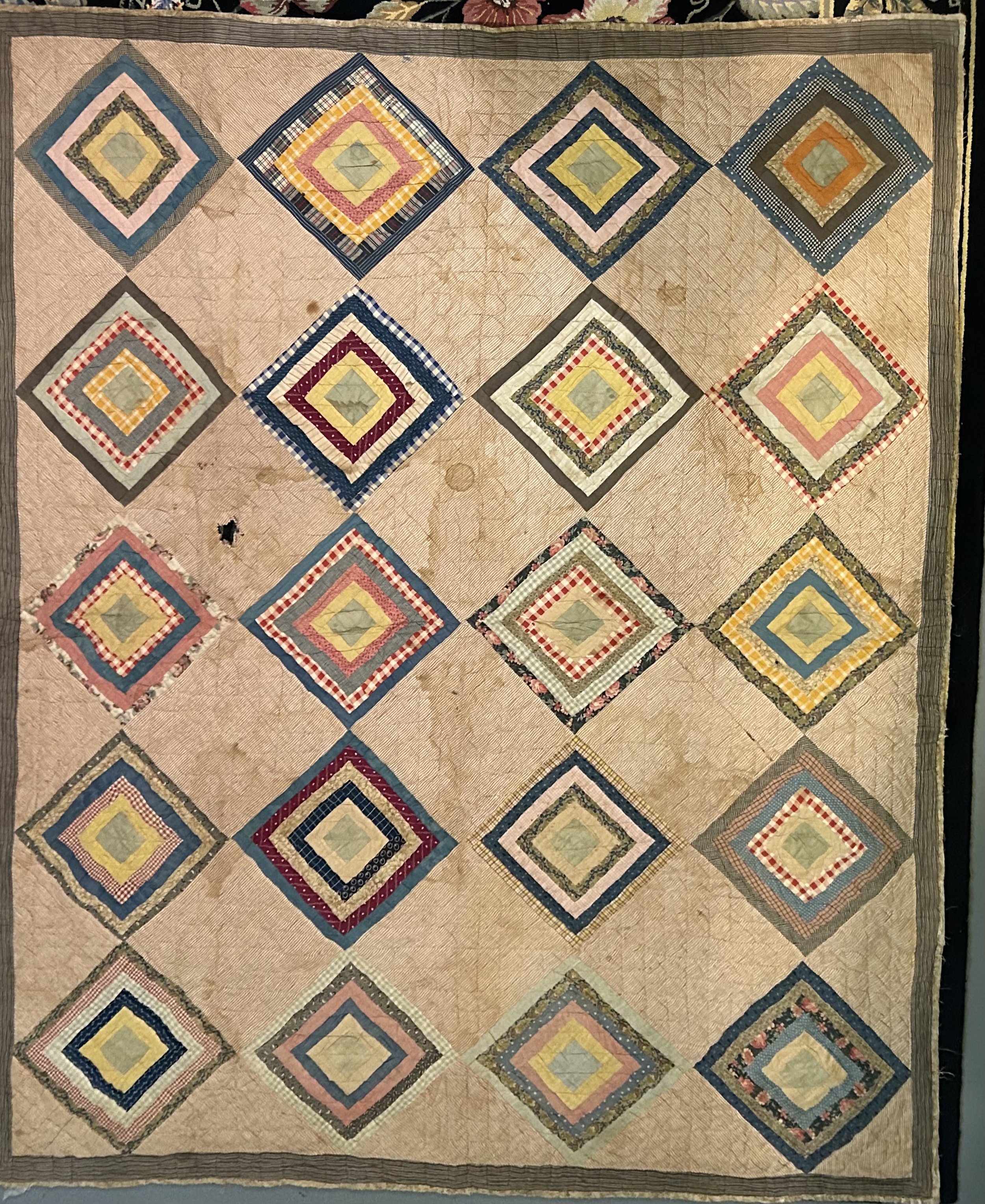$25K Quilt
No, I did not actually pay $25,000 for this Civil War era cotton quilt. A friend found it at the Bins while we were thrifting, and gave it to me. Based on weight it cost $5.35, including tax, but not including the remarkable amount of dirt (now gone – didn’t think to weigh it dirty). I decided to buy it anyway, mainly because I was curious what it looked like, but also I wanted to experiment with cleaning something so old. I typically wash old quilts in a bathtub, using shampoo as well as vintage cleaner (restoration-fabric-restorer/). This involves numerous rinses, lots of towels and an ability to drape the quilt to dry. Ideally, I do this on a sunny day so the quilt can dry outside in the sun. Not an option on the rainy cold March day I brought it home, so I put it aside to wait a few days for the weather to warm. And promptly lost water service to our property for 14 days.
The quilt sat in a laundry basket sadly rumpled awaiting its spa treatment, while we struggled through 2 weeks without running water. The ability to have water at whim is not something to take lightly. Sadly, being able to turn back on the water ended up costing $25,000 due to the need to create an entirely new water connection for our property. The process of rebuilding the water connection, when started, went remarkably quickly for all that was involved. Myriad men, mostly covered in mud, traipsed in and out of our houses: plumbers, excavators, inspectors. My husband – who, mind you, had shoulder surgery while all this was going on - is convinced my plying them all with cookies endeared them all to me, but baking cookies was a small price to pay. Not like the actual bill. Sigh.
The first thing I did once water was back on was rescue my Civil War quilt from its laundry detention and start the cleaning process. Dear lord I should have taken a photo of the FILTHY water. I have no idea how the thing got so dirty, but I suspect it had not been washed in 100 years. After drying in the sun, I could actually see the details of the quilt. The quilter used a “rough” fabric for the center green squares and first round of yellow in each block. This fabric was likely American-made as the cotton economy of slavery in the mid 1800s sent most raw cotton to England to be woven into fine fabrics. Fabrics made in the United States at that time were more utilitarian, like the green, yellow and other solid colored fabrics in the quilt. The remaining fabrics, used in the logs of the “log cabin” pattern are a variety of scraps. Some are prints used “straight on the grain” like the blue check. Others are on a diagonal (bias) which is clear to see in the red shirting fabric in this block. The quilter likely used worn clothing as scraps, making due with what was available, particularly when she ran out of blue check and substituted blue bubble fabric! The setting blocks are all the same pink stripe fabric, and would have been a purchased yardage. A yard of fabric during the Civil War ran around 75 cents, comparable to $30 a yard today, which is very expensive, even by modern standards. Purchasing yardage in the 1860s was a luxury for wealthier households, or a splurge for a significant project.
This quilt is not fancy, uses up clothing scraps the maker had available, and was quilted quickly in a simple cross hatch design. It definitely has some sadness – a random hole on the front, and numerous fabrics that have not held up well. The back is much worse as that fabric was a very light-weight print that became threadbare over time. But the quilt was cherished. Many quilts from this era were made to send to soldiers fighting in the Civil War (1861-1865), sometimes for specific family members and sometimes for charities providing quilts to veterans. Given the cost of the yardage and the fact the quilt was held onto by a family for over 150 years, I suspect it was used by a particular family soldier who returned from the war, quilt in tow.
As I found the quilt in a thrift store in southern Wisconsin, I am guessing it was made by a family from the area. Settles arrived in Wisconsin beginning in the 1830s, with a much larger influx coming after 1848, when Wisconsin became a state. I do wish this quilt could talk – what I wouldn’t give to know who made it, how it came to be in Wisconsin, and the life events it witnessed. Those stories will never be told, though in my mind they are worth every bit of $25k.



